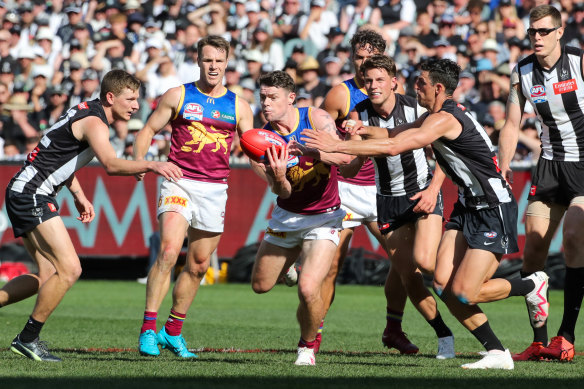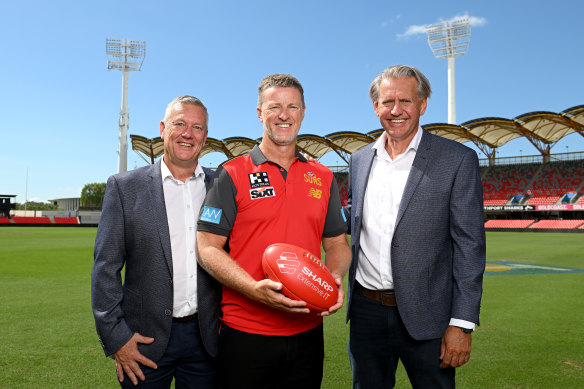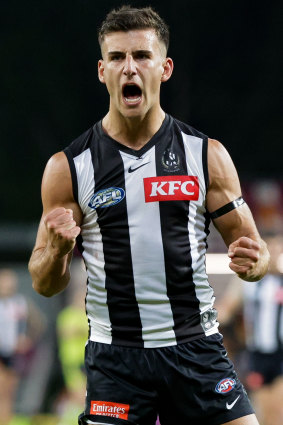By Jake Niall
“Always back self-interest – it’s the horse you know that’s trying.”
- Jack Lang, former NSW premier, to future prime minister Paul Keating.
The AFL’s attempt to seek the input of clubs into what the league called “the competitive balance review” has distilled the genuine geographic and economic divisions that exist in the competition.
Unfortunately, on certain issues, the AFL’s review has given voice to an orgy of self-interest, point-scoring and whingeing.

Lachie Neale in action for the Brisbane Lions in last year’s grand final at the MCG. Credit: Paul Rovere
At a time when heavyweight clubs are seeking more influence over the AFL Commission, the naked self-interest of clubs has underscored why the game still needs a wholly independent commission to judge what is genuinely “in the best interests of the game” rather than in the interests of particular clubs.
This does not mean the commission is fully functional, but it reminds us that the clubs will always act in accordance with Jack Lang’s maxim.
That said, a fair portion of the ideas proposed are sober and intelligent. The Lions’ travel suggestions, aired in this masthead on the weekend, are thoughtful and considered. Some are simply self-interested and a handful are theatrical attempts to make noise and gain the attention of the media, thereby getting the AFL to jump, or to protect one’s patch.

Gold Coast chief executive Mark Evans, coach Damien Hardwick and chairman Bob East.Credit: Getty Images
If there were medals for the most self-interested suggestions, the Swans would certainly be on the podium with their idea of turning the grand final into a best-of-three series. It is noteworthy that this reality defiant idea – fully ventilated in the media by the Sydney leadership – did not form part of the club’s official submission to the AFL.
Not to be outdone, Gold Coast chief executive Mark Evans went on the record with the far-fetched concept of playing the entire first week of the finals out of Victoria, irrespective of ladder position. Again, this was not a serious suggestion and was really about pushing back against those who wanted the Suns to lose their academy bid discount in the draft or other concessions.
Then, the Dockers and Eagles floated the notion that the 10 Victorian teams could each take turns in playing a home game in Perth, as a means of equalising the vast disadvantage that WA teams had in their seasonal travel. This was another idea that seemed to be making a broader point about the Vic-centric nature of the competition.
St Kilda, meanwhile, have been the loudest voice against the northern academies and father-son bidding systems, which is the hobby horse of Saints president Andrew Bassat and which Ross Lyon further questioned on Friday.

Collingwood star Nick Daicos.Credit: AFL Photos
Rivals quickly pointed to St Kilda’s notorious own goals in recruiting and, indeed, in relocating to and from Seaford, as far more responsible for their dismal past decade (and current challenges) than whether they slide down a few draft spots via the bidding system for players tied to rivals. Undeterred by their history, the Saints are looking at the road ahead and for a purer draft – at least until the progeny of the Riewoldt generation throws up a Nick Daicos or Sam Darcy.
Collingwood wanted shorter games (though one wonders how many they’d win if they didn’t have the last few minutes), Carlton have been lobbying intently not against the imminent changes to the father-son and academy bids but for those changes, like tax hikes, to be delayed until the Camporeale twins are secured this November.
The competition has four or five groupings or power blocs. One is the northern bloc, consisting of the four clubs in NSW and Queensland. They will retain their academies, which are under no threat, but there remains a question of the price they pay in the draft for those players.
These clubs are not actually the same, any more than the big V power grouping of Carlton, Collingwood, Essendon, Richmond and Hawthorn are, but they have enough shared interests to form a bloc. The Swans and Lions are strong, established clubs, the Suns and GWS are not.
The AFL must consider whether they must be treated as a gang of four, or separated, when it comes to the bidding system and academies. The Lions, for instance, have attracted more A-graders from rivals – starting with Lachie Neale and Charlie Cameron – than any other club, while Sydney’s academy has yielded far more than that of GWS. And while there is hysteria about the Suns’ academy, that club is still yet to play finals after 13 seasons.
While some of the noise and self-interested rhetoric – not all of which has been contained in the clubs’ submissions – has created divisions and engendered a culture of complaint, the likely upshot will be relatively modest changes.
The father-son, academy and NGA bid systems will change. The arcane points system will be less generous to most, if not all, clubs. There will be more future picks and perhaps some mild reforms around travel, as per the Lions’ submission.
But the grand final will not be moved. The Swans et al will keep their academies. The Camporeale twins will land at Carlton. And next time the AFL allows the clubs to have a voice on important issues, they might not let it run for eight or nine months.
Keep up to date with the best AFL coverage in the country. Sign up for the Real Footy newsletter.